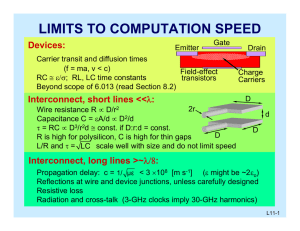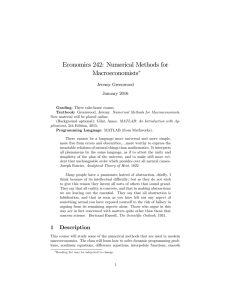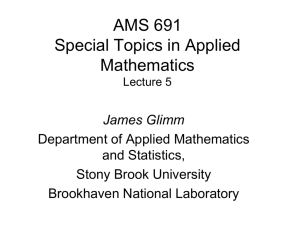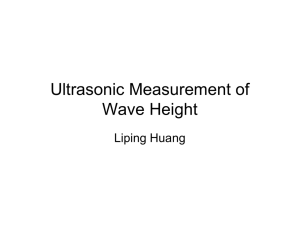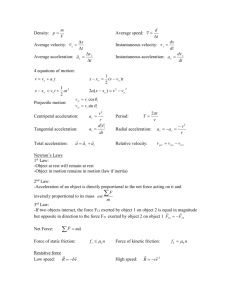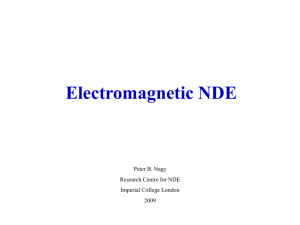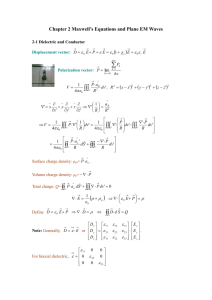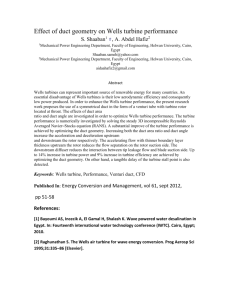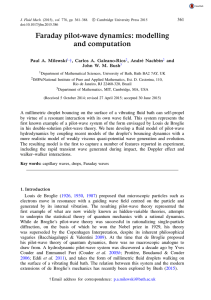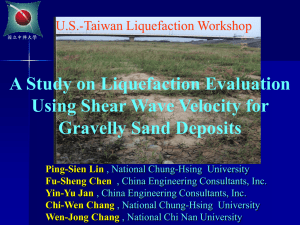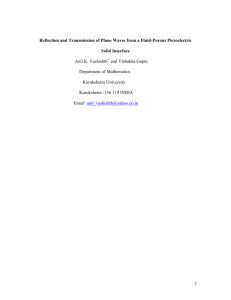Final Exam
advertisement
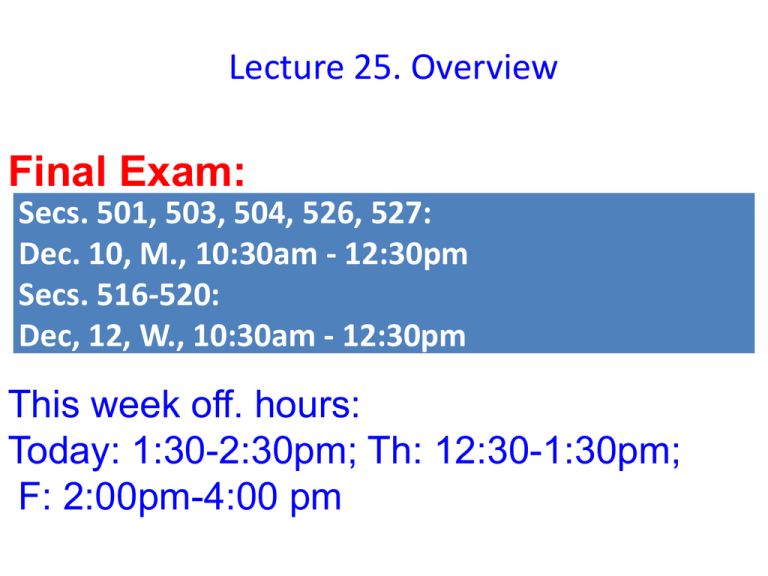
Lecture 25. Overview
Final Exam:
Secs. 501, 503, 504, 526, 527:
Dec. 10, M., 10:30am - 12:30pm
Secs. 516-520:
Dec, 12, W., 10:30am - 12:30pm
This week off. hours:
Today: 1:30-2:30pm; Th: 12:30-1:30pm;
F: 2:00pm-4:00 pm
Evaluation is helpful!
• You should all have received an email with a
link to evaluate your PHYS 208 class.
• I encourage you all to fill this out
• It gives a feedback to me and TAs
• This year it’s especially important in view of
of coming revolutionary changes in teaching:
1) big classes (1 lecturer for all),2) flipped
lectures (pre-lectures for learning the concepts
and no derivations by lecturer on board),
3)multiple choice exams.
The Course Grade (CG):
CG=(3E+2xF+R+L/2+HW+CP)/7.
3 Exams (3E)
300
Final Exam (F)
100
Homework (HW)
Laboratory (L)
50
100
Recitation (R)
100
Class Points (CP)
not limited
A: >90, B: 80-90, C: 70-80, D: 55-70, F<55
Check your Midterm Exams Grades on elearning!
Average E1=61+5 (curve)
Average E2=56+5 (curve)
Average E3=56+5 (curve)
Average A3E=(E1+E2+E3+15)/3=63
Average lab grade: (AL)=92
Average rec. grade (AR)=82
For students with A3E=63, AL=92, AR=82, HW=50
Before Final Exam:
ACG=(3xA3E+R+HW+L/2)/5=73.
For students with A3E=63, L=100, R=100, HW=50
Before Final Exam:
ACG=(3xA3E+R+HW+L/2)/5=78.
If FE>min {E1,E2,E3} then min{E1,E2,E3}
FE
Then the course grade is calculated as:
The Advanced Course Grade (ACG):
ACG=(2E+3xF+R+L/2+HW+CP)/7.
If before curve of FE
FE>90 then CG is A;
FE>80 and FE>max{CG,ACG} then CG=B
FE>70 and FE>max{CG,ACG} then CG=C
FE>55 and FE>max{CG,ACG} then CG=D
Webct homework (HW) is due by Dec.10.
To get full credit (50p) complete HW 1-12
Last HW (N13) is not required!
You get 25p if complete >6HW but <12HW
If you complete <6HW you get no credit
Final Exam: (Ch.21-24, 27-29, 32,33,35,36)
Two Parts:
2 problems (50p) old material : Chs. 21-24, 27-30
2 problems (50p) new material : Chs. 32, 33, 35,36
Students may be excused from the first part if
1) Each midterm exam is higher or =85 (with a curve)
2) An average of 3 exams is higher or = 90 (with a curve)
In this case the Course Grade: CG= (3E+F+R+L/2+HW+CP)/6.
Preparation to the final exam
•
•
•
•
•
•
•
•
This lecture
Formula sheet
Old Final Exams
Old 1st and 3d exams
Lectures notes (especially, Examples)
Homework
Textbook
Sleep well!
Ch.21-23 (Lect.1-6)
1.Electric field, electric force
kQ
E 2 r0
FQq qEQ
r
2. Potential (voltage),
potential
energy
b
Vab E dl
U (r ) q0V
V=kq/r
a
3. Superposition principle
4. Gauss’s Law E dA Qencl
surface
0
5. Energy conservation law, work
Ka+Ua= Kb+Ub
Wab =Ua-Ub
kdq
kdq
dV (r )
,
2
2
r
a x
k
kQ
V dV
dq
2
2
2
2
a
x
a
x
ring
ring
Example. A uniformly charged thin ring has a radius10 cm and a
total charge 12 nC. An electron is placed on the ring axis a distance 25 cm
from the center of the ring. The electron is then released from rest.
Find the speed of the electron when it reaches the center of the ring.
U ( x) U (0) K (0)
K (0) U ( x) U (0) q[V ( x) V (0)]
kQ
kQ
V ( x)
; V ( x 0)
a
a2 x2
2keQ 1
1
v
[
]
2
2
m a
a x
m v2
1
keQ[
2
a
a x
2
2
]
1
1
]
2
2
0.1m
(0.1m) (0.25m)
7
1
.
54
10
m/ s
31
2 2
9 10 kg C
2 9 109 Nm 2 1.6 1019 C 12109 C[
1
Calculation of E using Q
E dA
the Gauss’s law
encl
surface
Three types of charge distribution symmetry
Spherical A=4 π r2, V=4 π r3/3
Cylindrical Aside=2 π rL, V= π r2L
L →∞
Plane A=L1L2, V=AL3
L1, L2 →∞
0
Example. Very long conducting cylinder, L>>R, r
Q
L
L
1. r<R: E(r)=0→V(r)=V(R)
2. r>R:
For infinitely long charged objects never choose V(r→∞)=0 !!!
Choose V(R)=0.
V(r)
R
dr
R
r
V (r ) 2k
2k ln 2k ln
r
r
R
r
r
Ch.27-28 (Lect.12-15)
Magnetic force on a moving charge F qv B
Motion of the charged particles in B; crossed B and E
Force on a segment of a current
Amper’s law
B dl I
F I Bl
Example1. At t=0 proton with v=(1.5x105 i+2x105 j)m/s enters at the origin of
the coordinate system the region with B=0.5iT. Describe and plot the pass.
Find the coordinates of the proton at t=T/2 where T is the period of the circle.
F qv B
y
F m a qvy B
m vy
2
R
2R 2m
R
, T
qB
vy
qB
m vy
F
y (t T / 2) 0, z (t T / 2) 2 R,
x(t T / 2) v x T / 2
z
y
Vy
z
B
R
F
Motion of q in B┴E.
Velocity selector
E
qvB qE v
B
Independent on the mass and q
Particles with this velocity will be undeflected. Particles with larger velocity will
be deflected by B. Particles with smaller velocity will be deflected by E.
Amper’s law: Conducting cylinder
1.r R
I
B 2r 0 Jr , J 2
R
0 Ir
B
2R 2
0 I
r R:B
2R
2.r R
B 2r 0 I
2
0 I
B
2r
Lect.16,17,20 (Ch.29,32)
d B
Law of EM Induction (Faraday’s law)
dt
a
Motional emf
( v B ) dl
b
Major characteristics of e.m. waves
0
n
Absorbing plane
Malus’s law
u
EB
Prad
I
c
EB
S
P S dA, U Pdt
Nonabsorbing plane
I out Iin cos
2
E vB
c
v
n
A
Prad
2I
c
T
P
F Prad A
c
I
Random
I out I in cos 2 in
polarization
2
n Km K
Lenz’s law
Magnetic field produced by induced
current opposes change of magnetic flux
Slide-wire generator
vBl
Origin of this emf is in separation of charges
in a rod caused by its motion in B due to
magnetic force F qv
B
The secondary magnetic force
Fm ' I Bl
Fext Fm ' I Bl
2
2
(
vBl
)
Pel I 2 R
R
R
dW
dx
(vBl) 2
Pmech
Fext
IBlv Blv
dt
dt
R
R
Example. Find motional emf in the rod.
(v B) dl
L
0
I
V
+
d
L
F qv B
V
I
+
-
+
-
0 I
B
2r
0 I
v
2
d L
d
dr 0 I d l
v
ln
r
2
d
Example. Find induced current in the
loop with resistance R.
I=0
Induced nonelectrostatic electric field when B(t)
Find E(r).
d B
E dl dt
1.r R
dB
E 2r r
dt
B ni, K m 0
2
E
n di
2 dt
2) r R
r
dB
E 2r R
dt
n di R 2
E
2 dt r
2
R
General form of Amper’s law (displacement current)
d E
B dl (i dt )
μ= Kmμ0, ε=Kε0,
In free space K=1, Km =1
Let’s find B between the plates.
1.r R
r2
B 2r 0 jd r 0ic 2
R
id
ic
jd 2
A R
0ic r
B
2 R 2
2.r R
B 2r 0id
2
B
r
R
0ic
B
2r
B
X X X
E
X X X
E and B in e.m. wave
E y E0 cos(t kx)
Bz B0 cos(t kx)
or
E j E0 cos(t kx)
B k B0 cos(t kx)
E y E0 cos(t kx)
Bz B0 cos(t kx)
or
E j E0 cos(t kx)
B k B0 cos(t kx)
This is y-polarized wave. The direction of E oscillations determines polarization of the wave..
Example. A carbon-dioxide laser emits a sinusoidal e.m. wave that travels in vacuum in the negative x direction. The
wavelength is 10.6μm and the wave is z-polarized. Maximum magnitude of E is 1.5MW/m. Write vector equations for
E and B as functions of time and position. Plot the wave in a figure.
E k E0 cos(t kx)
B j B0 cos(t kx)
E0 1.5 106 V / m
3
B0
5
10
T
8
c
3 10 m / s
2 2 3.17rad
5
k
5
.
93
10
rad / m
6
10.6 10 m
ck (3 108 m / s ) 5.93105 rad / m 1.781014 rad / s
NB: Since B=E/c→B (in T) <<E (in V/m)
Standing Waves
If two conductors are placed parallel to each other on the distance L the
nodes of E should be on the ends (just as on the string with fixed ends)
max
v
v
L max 2 L f min
2
max 2 L
2L
vn
n
, n 1,2... f n
f minn
n
2L
Example. In a microwave oven a wavelength 12.2cm (strongly absorbed by a water) is used.
What is the minimum size of the oven? What are the other options? Why in the other options
rotation is required?
Lmin
6.1cm
2
L 12.2cm onenodein the m iddle
L 18.3cm...
Example
A radio station on the surface of the earth radiates a sinusoidal wave with an avearge total power 50kW. Assuming that
transmitter radiates equally in all directions, find the amplitudes of E and B detected by a satellite at a distance 100km.
P
5 104
7 W
I
7.9610
2
10
2
2R
6.2810 m
m2
2
E0 B0
E0
I
20
20c
E0 2 0 cI 2.5 10 2 V / m
E0
B0
8.2 1011 T
c
Malus’s law
Eout
In general case when linear plz wave goes through the filter
only its projection on the axis of the filter goes through.
Ein
Eout Ein cos
I out Iin cos2
Unpolarized em wave (random
polarization)
I out I in cos 2
I in
2
NB: After the filter em
wave is always linear
polarized along the
axis of the filter.
Lect. 23 (Ch.35)
Conditions for constractive and distractive
interference (i) for phase difference
(ii) for path difference
Double-slit experiment
Interference in the thin films
Phase difference and Path difference
E1 E0 cos(t kr1 )
r1
E2 E0 cos(t kr2 0 )
S1
k (r2 r1 ) 0 kr 0
r2
S2
1. 2m I t 4 I 0 ( Et 0 2 E0 ) constractive int erfernce
1
2. 2 (m ) I t 0 ( Et 0 0) destructive int erference
2
3.
2
(2m 1) I t 2 I 0 ( Et 0 2 E0 ) no int erference
2
Taking into account that
k
In particular case when
0 0
1.r m constractive int erfernce
1
2. r (m ) destructive int erference
2
1
3.r (m ) no int erference
2
2
Max and min positions (bright and dark stripes)
If R d r r2 r1 d sin , kr
max : 2m d sin m
1
1
min : 2 (m ) d sin (m )
2
2
If is sm allsin tan
Rm
max : ym
d
R (m 1 / 2)
min : ym
d
y
R
Intensity distribution
I t 4 I 0 cos2 ( / 2) 2 I 0 (1 cos ),
Constructive int ereference: I t 4 I 0
Destructice int erefernce: I t 0
No int erference: I t 2 I 0
Example
A radio station operating at a frequency of 1500kHz has two identical vertical dipole antennas
spaced 400m apart, oscillating in phase. At distances much greater then 400m, in what
directions is the intensity greatest in the resulting radiation pattern? If intensity produced by
each antenna 400km away along y axis is 2mW/m2 what is the total intensity produced by two
antennas at this point?
y
c 3 108 m / s
1.
200m
6
f 1.5 10 1 / s
m m(200m) m
max : d sin m sin
d
400m
2
m 0 0, m 1 30 , m 2 90
| m | 2 sin 1 im possible. 2.I 4 I 0 8m W / m 2
Interference in the thin films
Normal coincidence:
k 2t , k
2
film
1
1
1. max : 2m 2t film (m ) 0 (m )
2
n film
2
m0
1
2. min : 2 (m ) 2t m film
2
n film
film
n<nfilm
Example
The walls of a soap bubble have about the same refractive index as a plain water, n=1.33.
In the point where the wall is 120nm thick what colors of incoming white light are the most
strongly reflected?
0
1
max : 2t
(m )
n film
2
m 0, 0 4tn film 4 120nm 1.33 640nm (orange)
m 1, 0
640nm
213nm(UVradiation, nonvisible)
3
Interference at the thin wedge of air
NB: Interference between the light reflected from
the upper and lower surfaces of the glass plate is
neglected due to the larger thickness of the plate.
1
max : 2t 0 (m )
2
min : 2t m0
NB: the fringe at the line of contact is dark,
because of
phase shift produced by
reflection from the second plate.
Example
A monochromatic light with wavelength in the
air 500nm is at normal incidence on the top
glass plate (see the figure). What is the
spacing of interference fringes?
x l
tl
x , min : 2t m0
t h
h
m0l
0l (500109 m)0.1m
xm
, xm1 xm
1.25m m
3
2h
2h
2(0.0210 m)
The position of the first minimum in diffraction pattern
1
(a / 2) sin / 2
a
Diffraction grating
max: 2m d sin m
E0 t
Eot NE0 I ot N I 0!
2


